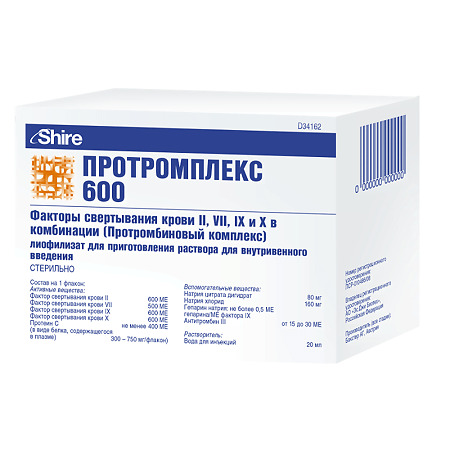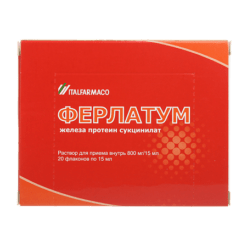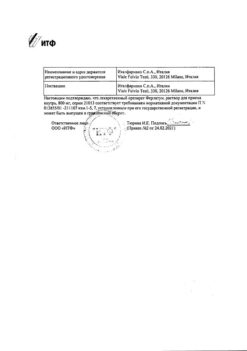No products in the cart.
Prothromplex 600,
€1.00
Out of stock
(E-mail when Stock is available)
Description
The clotting factors II, VII, IX and X together form the prothrombin complex. The synthesis of these factors depends on vitamin K and is carried out in the liver. Factor VII is a zymogen of active serine-protease factor VIIa, through which the endogenous clotting pathway is initiated.
The tissue factor – factor VIIa complex activates clotting factors X and IX, resulting in the formation of factors Xa and IXa. With further activation of the clotting cascade, prothrombin (factor II) is activated and converted into thrombin. Under the action of thrombin, fibrinogen is converted into fibrin, which leads to the formation of a clot. Normal thrombin synthesis is also a prerequisite for platelet participation in primary hemostasis. Isolated severe factor VII deficiency leads to decreased thrombin formation and causes increased bleeding due to impaired fibrin formation and impaired primary hemostasis. Isolated factor IX deficiency is one of the classic types of hemophilia (hemophilia B).
Isolated factor II or factor X deficiency is very rare but, in severe forms, is accompanied by increased bleeding as in cases of classical hemophilia.
Acquired deficiency of vitamin K-dependent clotting factors of the prothrombin complex occurs during treatment with vitamin K antagonists. In severe deficiency, the tendency to bleed is increased, with retroperitoneal and cerebral bleeding rather than bleeding into muscles and joints being characteristic. Severe liver failure also results in markedly reduced levels of the prothrombin complex and clinically pronounced symptoms of increased bleeding, which, however, in most cases is complex, due to simultaneous weak intravascular clotting, low platelet levels, clotting inhibitor deficiency and impaired fibrinolysis.
The administration of human prothrombin complex product provides an increase in plasma levels of vitamin K-dependent clotting factors and may temporarily correct coagulation disorders in patients with a deficiency of one or more of these factors.
Indications
Indications
Active ingredient
Active ingredient
Composition
Composition
Active substances:
clotting factor II 600 IU,
clotting factor IX 600 IU,
clotting factor VII 500 IU,
How to take, the dosage
How to take, the dosage
Treatment should begin under the supervision of a physician experienced in the treatment of blood clotting disorders. Doses and duration of replacement therapy depend on the severity of the disease, localization and severity of bleeding, as well as the clinical condition of the patient.
The dose and frequency of administration should be calculated for each patient individually. The intervals between injections should correlate with the various T1/2 factors of the prothrombin complex.
Individual doses may be determined based on regular monitoring of plasma levels of relevant clotting factors, or by regular determination of individual levels of clotting factors of interest, or by common tests to determine prothrombin complex levels (e.g., Quick value prothrombin, prothrombin time and INR) and ongoing monitoring of patients’ clinical status.
In the case of a massive surgical intervention, close monitoring of replacement therapy with coagulation tests (analysis of levels of specific clotting factors and/or general tests to assess the level of the prothrombin complex) is necessary.
Bleeding and bleeding prevention during surgical interventions in patients receiving vitamin K antagonist drugs
In case of severe bleeding or before surgery with a high risk of bleeding, normal prothrombin complex values should be sought: “prothrombin by Quick 100%, MHO=1). The following rule of thumb applies: 1 ME of the drug/kg body weight increases prothrombin by about 1% according to Quick.
Bleeding and prevention of bleeding during surgical interventions in patients with congenital deficiency of one of the vitamin K-dependent clotting factors, in cases where a clotting factor drug is not available
/p>
The calculation of the dose required for treatment is based on empirical evidence that approximately 1 ME of factor VII or factor IX per kg body weight increases plasma factor VII activity by 0.019 ME, and plasma factor IX activity by 0.09 IU/mL. 1 ME of factor II or X per kg body weight increases factor II or X activity in plasma by 0.02 ME/ml and 0.017 ME/ml, respectively.
The administered dose of specific factor is expressed in International Units (ME), which are determined according to the current WHO standard for each factor. Plasma specific clotting factor activity is expressed as either a percentage (relative to normal plasma) or ME (according to the international standard for specific clotting factor). 1 IU of clotting factor activity is equivalent to the amount in 1 ml of normal human plasma. For example, the calculation of the required dose of Factor X is based on the empirical evidence that 1 ME of Factor X/kg body weight increases Factor X activity in plasma by 0.017 IU/ml.
The required dose is calculated using the following formula: Required dose (ME) = body weight (kg) Ã desired increase in factor X (ME/ml) Ã 60, where 60 (ml/kg) is the inverse of the established recovery value. If the individual recovery value is known, it should be used to calculate the dose.
Interaction
Interaction
The prothrombin complex preparations neutralize the effects of vitamin K antagonists.
There have been no studies to study interactions with other medicinal products.
Pharmaceutical Incompatibilities
Protromplex 600 must not be mixed with other drugs or solvents except for the supplied sterile water for injection.
The effectiveness and tolerability of the drug may be impaired if it is mixed with other medications. It is recommended to flush the venous catheter with sodium chloride isotonic solution before and after administration of Protromplex 600.
Special Instructions
Special Instructions
In patients with acquired deficiency of prothrombin clotting factors (e.g. due to treatment with vitamin K antagonists) Prothromplex 600 is used when rapid correction of clotting factor levels is necessary, particularly in life-threatening and severe bleeding, especially retroperitoneal, cerebral, gastrointestinal, and when urgent surgical intervention is required. In other cases, a reduced dose of vitamin K antagonist and/or vitamin K administration is usually sufficient.
In congenital isolated deficiency of one of the vitamin K-dependent factors, a monocomponent clotting factor deficient drug should be used first. Patients with congenital clotting factor deficiency should be counseled by a specialist experienced in treating patients with this pathology.
Bleeding in patients with acquired vitamin K-deficiency of clotting factors may occur with prolonged therapy or overdose of oral indirect anticoagulants (vitamin K antagonists); In diseases of hepatopancreatoduodenal organs (cirrhosis, hepatocellular carcinoma, obstruction of common bile duct by a stone or stricture, drainage of common bile duct, chronic pancreatitis); in intestinal diseases, leading to impaired vitamin K absorption (“short bowel” syndrome due to surgery; Crohn’s disease); in prolonged parenteral nutrition without supplementation of vitamin K; as a result of treatment with certain medications (cefamandole, cefoperazone, rifampicin, isoniazid, barbiturates, chemotherapeutic agents that damage the liver parenchyma) in diseases accompanied by production of coagulation inhibitors (lupus anticoagulant, multiple myeloma and other paraproteinemia), in acute promyelocytic leukemia, with massive blood loss.
Multicenter clinical studies of Protromplex 600 in children have not been conducted.
In case of allergic or anaphylactic reactions the drug administration should be stopped immediately. In case of shock it is necessary to provide standard antishock medical measures.
The standard measures to prevent infections resulting from the use of drugs derived from human blood or plasma include donor selection, screening of individual donor samples and plasma pools for specific markers of infection, and the use of effective viral inactivation/removal processes in manufacturing. Despite this, the transmission of an infectious agent cannot be completely ruled out when using drugs derived from human blood and plasma. This also applies to unknown or new viruses and other pathogenic agents.
The measures taken are considered effective against enveloped viruses such as HIV-1/2, hepatitis B and C viruses, and the shameless hepatitis A virus.
The removal and inactivation technologies used may not be sufficiently effective against some shell-free viruses, such as parvovirus B19. Infection with parvovirus B19 can be dangerous for pregnant women (infection of the fetus) and immunodeficient patients, for patients with increased red blood cell decay (e.g. hemolytic anemia).
In regular use of preparations made from human plasma, the patient should be vaccinated against hepatitis A and hepatitis B.
Each time Protromplex 600 is administered to a patient, the name of the drug and the series number should be recorded in the patient’s medical history or chart.
There is a risk of thrombosis and disseminated intravascular clotting when repeated administrations of human prothrombin complex products, including Prothromplex 600. The risk may be higher when treating isolated factor VII deficiency because other vitamin K-dependent clotting factors with longer T1/2 could accumulate to levels significantly higher than normal.
Patients receiving prothrombin complex therapy should be monitored closely for symptoms of intravascular clotting or thrombosis. Patients with CHD, liver disease, patients prone to thrombosis, newborns, and pre- and postoperative patients are indicated for monitoring. In these patients, the potential benefit of treatment must be weighed against the risk of complications.
Laboratory tests. Note that the drug contains heparin, which is important when performing heparin-sensitive coagulation tests, especially if the drug is used in high doses.
Because heparin can cause allergic reactions and decreased blood cell counts, which affect the clotting system, heparin-containing medications should be avoided in patients with a history of heparin-induced allergic reactions.
The bottle with Protromplex 600 contains 80 mg of sodium. This should be taken into account when prescribing the drug to patients on a low-sodium diet.
At the stated shelf life, patients can store the drug at room temperature (not exceeding 25°C) for 6 months. The date of beginning of storage at room temperature should be noted on the package. If the drug has been stored at room temperature for 6 months, it must either be administered to the patient or disposed of. Subsequent storage in the refrigerator is not acceptable.
The reconstituted solution is chemically and physically stable when stored for 3 h at 20° to 25°C. The reconstituted solution should not be stored in the refrigerator. Since the preparation contains no preservatives, from the microbiological point of view the prepared solution should be used immediately.
Impact on driving and operating machinery
There have been no studies to study the effect of the drug on driving and operating vehicles.
Contraindications
Contraindications
Side effects
Side effects
In rare cases – fever, headache, vomiting, BP changes, itching, reddening of the skin, in some cases – decrease in the number of platelets and fibrinogen levels, the appearance of PDP and D-dimer, thrombotic complications (including myocardial infarction).
Overdose
Overdose
In cases of overdose of prothrombin complex preparations, no cases have been described. Based on the pharmacodynamic properties of the drug, it can be assumed that the possible manifestations of overdose will be thrombotic complications.
Pregnancy use
Pregnancy use
The safety of human prothrombin complex preparations in pregnant women and during lactation has not been determined.
Animal studies are not suitable to evaluate safety with respect to pregnancy, fetal/fetal development, labor and postnatal development. Therefore, human prothrombin complex should only be used in pregnancy and during lactation if there are strict indications, if the expected effect of therapy exceeds the potential risk to the fetus.
Additional information
| Shelf life | 3 years |
|---|---|
| Conditions of storage | In the dark place at 2-8 °C (do not freeze) |
| Manufacturer | Baxter Pharmaceutical Solutions LLC, USA |
| Medication form | solution for infusion |
| Brand | Baxter Pharmaceutical Solutions LLC |
Related products
Buy Prothromplex 600, with delivery to USA, UK, Europe and over 120 other countries.















